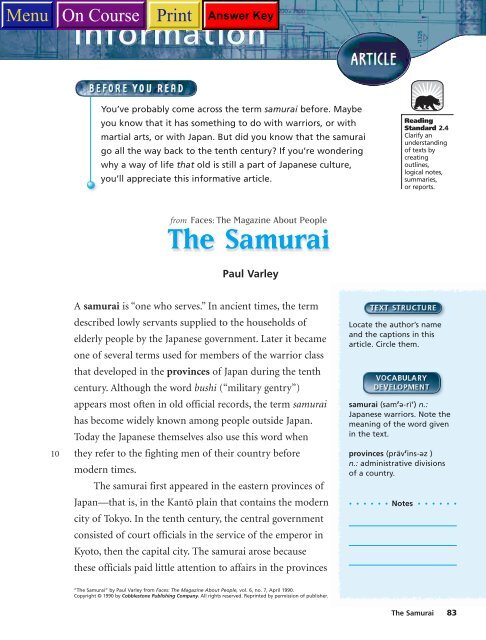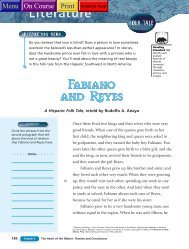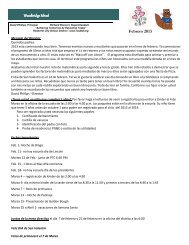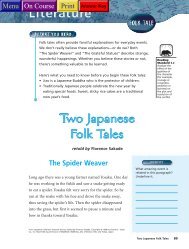A samurai is âone who serves.â In ancient times, the term described ...
A samurai is âone who serves.â In ancient times, the term described ...
A samurai is âone who serves.â In ancient times, the term described ...
Create successful ePaper yourself
Turn your PDF publications into a flip-book with our unique Google optimized e-Paper software.
You’ve probably come across <strong>the</strong> <strong>term</strong> <strong>samurai</strong> before. Maybe<br />
you know that it has something to do with warriors, or with<br />
martial arts, or with Japan. But did you know that <strong>the</strong> <strong>samurai</strong><br />
go all <strong>the</strong> way back to <strong>the</strong> tenth century? If you’re wondering<br />
why a way of life that old <strong>is</strong> still a part of Japanese culture,<br />
you’ll appreciate th<strong>is</strong> informative article.<br />
Reading<br />
Standard 2.4<br />
Clarify an<br />
understanding<br />
of texts by<br />
creating<br />
outlines,<br />
logical notes,<br />
summaries,<br />
or reports.<br />
Paul Varley<br />
10<br />
A <strong>samurai</strong> <strong>is</strong> “one <strong>who</strong> <strong>serves</strong>.” <strong>In</strong> <strong>ancient</strong> <strong>times</strong>, <strong>the</strong> <strong>term</strong><br />
<strong>described</strong> lowly servants supplied to <strong>the</strong> households of<br />
elderly people by <strong>the</strong> Japanese government. Later it became<br />
one of several <strong>term</strong>s used for members of <strong>the</strong> warrior class<br />
that developed in <strong>the</strong> provinces of Japan during <strong>the</strong> tenth<br />
century. Although <strong>the</strong> word bushi (“military gentry”)<br />
appears most often in old official records, <strong>the</strong> <strong>term</strong> <strong>samurai</strong><br />
has become widely known among people outside Japan.<br />
Today <strong>the</strong> Japanese <strong>the</strong>mselves also use th<strong>is</strong> word when<br />
<strong>the</strong>y refer to <strong>the</strong> fighting men of <strong>the</strong>ir country before<br />
modern <strong>times</strong>.<br />
The <strong>samurai</strong> first appeared in <strong>the</strong> eastern provinces of<br />
Japan—that <strong>is</strong>, in <strong>the</strong> Kant£ plain that contains <strong>the</strong> modern<br />
city of Tokyo. <strong>In</strong> <strong>the</strong> tenth century, <strong>the</strong> central government<br />
cons<strong>is</strong>ted of court officials in <strong>the</strong> service of <strong>the</strong> emperor in<br />
Kyoto, <strong>the</strong>n <strong>the</strong> capital city. The <strong>samurai</strong> arose because<br />
<strong>the</strong>se officials paid little attention to affairs in <strong>the</strong> provinces<br />
Locate <strong>the</strong> author’s name<br />
and <strong>the</strong> captions in th<strong>is</strong><br />
article. Circle <strong>the</strong>m.<br />
<strong>samurai</strong> (sam√¥ • r¢≈) n.:<br />
Japanese warriors. Note <strong>the</strong><br />
meaning of <strong>the</strong> word given<br />
in <strong>the</strong> text.<br />
provinces (präv√ins • ¥z )<br />
n.: admin<strong>is</strong>trative div<strong>is</strong>ions<br />
of a country.<br />
• • • • • • Notes • • • • • •<br />
“The Samurai” by Paul Varley from Faces: The Magazine About People, vol. 6, no. 7, April 1990.<br />
Copyright © 1990 by Cobblestone Publ<strong>is</strong>hing Company. All rights reserved. Reprinted by perm<strong>is</strong>sion of publ<strong>is</strong>her.<br />
The Samurai 83
You can often find a clue to<br />
<strong>the</strong> meaning of an unfamiliar<br />
new word by breaking it up<br />
into smaller words that you<br />
know. Look at <strong>the</strong> word<br />
oversight (line 19). What<br />
smaller words do you see?<br />
Circle <strong>the</strong> words. Use <strong>the</strong><br />
meanings of <strong>the</strong> smaller<br />
words to help you define<br />
oversight.<br />
frontier (frun • tir√) n.: developing,<br />
often still uncivilized<br />
or lawless region of a<br />
country.<br />
shogun (◊£√gun≈) n.: any of<br />
<strong>the</strong> military governors of<br />
Japan <strong>who</strong>, until 1868, had<br />
absolute rule.<br />
Underline <strong>the</strong> definitions of<br />
<strong>the</strong>se words, which are given<br />
right in context on th<strong>is</strong> page:<br />
vassals; shogunate; serfs.<br />
Read <strong>the</strong> boxed passage<br />
aloud as if you were reading<br />
to a group of classmates <strong>who</strong><br />
are taking notes as you read.<br />
Make sure you emphasize<br />
<strong>the</strong> words and phrases that<br />
are given special treatment<br />
in <strong>the</strong> paragraph—those in<br />
italics, in paren<strong>the</strong>ses, and<br />
within quote marks.<br />
20<br />
30<br />
40<br />
except for making sure that <strong>the</strong>y received <strong>the</strong> income from<br />
<strong>the</strong>ir agricultural estates. Without effective oversight from<br />
<strong>the</strong> Kyoto court, men in <strong>the</strong> provinces took up arms to<br />
become a professional military class.<br />
<strong>In</strong> that period, <strong>the</strong> Kanto was a frontier area, rich in<br />
farmland and especially in need of men to maintain order<br />
as <strong>the</strong> territory developed. The <strong>samurai</strong> in <strong>the</strong> Kant£ and<br />
elsewhere organized <strong>the</strong>mselves into bands <strong>who</strong>se members<br />
were joined toge<strong>the</strong>r as lords and vassals (followers under<br />
a lord’s protection), much like <strong>the</strong> knights of medieval<br />
Europe.<br />
Although Japan <strong>is</strong> far from Europe and had no contact<br />
with Europeans until <strong>the</strong> mid-sixteenth century, <strong>the</strong><br />
Japanese developed a system of organizing society remarkably<br />
similar to that of medieval Europe. Th<strong>is</strong> system,<br />
known as feudal<strong>is</strong>m, took root in Japan with <strong>the</strong> founding<br />
of its first military government, or shogunate (government<br />
headed by a shogun, or “great general”), in 1185. As in<br />
Europe, feudal<strong>is</strong>m in Japan was based almost entirely on<br />
agriculture. Land divided into estates, or manors, was<br />
worked by peasants called serfs <strong>who</strong> had to remain on <strong>the</strong><br />
land and could not move about freely. Feudal<strong>is</strong>m also<br />
featured a ruling warrior or military class made up of lords<br />
and <strong>the</strong>ir vassals.<br />
<strong>In</strong> <strong>samurai</strong> society, a vassal was supposed to give<br />
absolute, unquestioning loyalty to h<strong>is</strong> lord and even be<br />
prepared to die for him in battle. <strong>In</strong> fact, <strong>the</strong> relationship<br />
between a lord and vassal went both ways: <strong>In</strong> return<br />
for performing military service, a vassal expected rewards<br />
and protection from h<strong>is</strong> lord. The idea of <strong>the</strong> loyal,<br />
self-sacrificing vassal was often ignored. Many vassals,<br />
84 Chapter 2 Characters: The People You’ll Meet
• • • • • • Notes • • • • • •<br />
Frightening <strong>the</strong> enemy was part of <strong>the</strong> strategy of <strong>the</strong><br />
<strong>samurai</strong>. <strong>In</strong> battle, <strong>the</strong>se warriors wore fierce-looking<br />
masks and fought fiercely, too.<br />
50<br />
especially in <strong>the</strong> tumultuous fifteenth and sixteenth<br />
centuries, betrayed or rebelled against <strong>the</strong>ir lords.<br />
The <strong>samurai</strong> continued to rule Japan until <strong>the</strong> beginning<br />
of <strong>the</strong> modern period in 1868. During <strong>the</strong> time of <strong>the</strong><br />
last military government, <strong>the</strong> shogunate of <strong>the</strong> Tokugawa<br />
family (1600–1867), Japan remained almost entirely at<br />
peace. Deprived of <strong>the</strong>ir profession of warfare, many<br />
tumultuous<br />
(tº • mul√¬º • w¥s) adj.:<br />
full of d<strong>is</strong>turbance or<br />
upheaval; unsettled.<br />
The Samurai 85
Re-read lines 51–60.<br />
According to <strong>the</strong> article, what<br />
happened to <strong>the</strong> <strong>samurai</strong><br />
during <strong>the</strong> shogunate of <strong>the</strong><br />
Tokugawa family? Underline<br />
th<strong>is</strong> information. How did<br />
th<strong>is</strong> h<strong>is</strong>torical happening<br />
contribute to <strong>the</strong> development<br />
of <strong>the</strong> martial art that<br />
<strong>is</strong> still practiced today?<br />
60<br />
<strong>samurai</strong> lived idly on payments provided by <strong>the</strong>ir lords.<br />
O<strong>the</strong>rs entered government service or professions such<br />
as teaching. As a substitute for actual fighting, <strong>the</strong> <strong>samurai</strong><br />
of <strong>the</strong> Tokugawa period developed <strong>the</strong> martial arts still<br />
practiced by many people in Japan and elsewhere.<br />
Members of <strong>the</strong> <strong>samurai</strong> class overthrew <strong>the</strong> Tokugawa<br />
shogunate and brought Japan into <strong>the</strong> Western-dominated<br />
modern world in <strong>the</strong> late nineteenth century. Although<br />
<strong>samurai</strong> status was officially d<strong>is</strong>solved in <strong>the</strong> 1870s, many<br />
people of <strong>samurai</strong> background continued to provide leadership<br />
in modernizing Japan. Moreover, <strong>samurai</strong> values<br />
remained deeply ingrained in <strong>the</strong> behavior of many<br />
Japanese at least through World War II.<br />
Th<strong>is</strong> <strong>samurai</strong> was photographed in 1860.<br />
86 Chapter 2 Characters: The People You’ll Meet
Clarify <strong>the</strong> Text Re-read “The Samurai.” As you read, highlight<br />
with a marker or circle <strong>the</strong> most important information revealed in<br />
<strong>the</strong> article. Then, use ano<strong>the</strong>r color highlighter to call out or draw a<br />
box around supporting details. Create an outline of <strong>the</strong> article on<br />
which you plot its main ideas and details. Your outline should follow<br />
th<strong>is</strong> style:<br />
I. Major topic<br />
A.Main idea<br />
1. Detail<br />
2. Detail<br />
B. Main idea<br />
1. Detail<br />
2. Detail<br />
Personal Word L<strong>is</strong>t Record new words in your Personal Word L<strong>is</strong>t.<br />
Put a star next to words you might use in a conversation.<br />
Personal Reading Log As you add th<strong>is</strong> selection to your Personal<br />
Reading Log, tell whe<strong>the</strong>r or not you’d like to read more about <strong>the</strong><br />
<strong>samurai</strong>. Give yourself 1 point on <strong>the</strong> Reading Meter for completing<br />
<strong>the</strong> article.<br />
Checkl<strong>is</strong>t for Standards Mastery You’ve just clarified a text by using<br />
<strong>the</strong> skill of outlining. Now, track your progress by using <strong>the</strong> Checkl<strong>is</strong>t<br />
for Standards Mastery.<br />
The Samurai 87
The Samurai <strong>In</strong>teractive Reading, page 83<br />
Go Beyond an <strong>In</strong>formational Text<br />
Research Template The <strong>samurai</strong> of long ago provide a fascinating<br />
topic for research. Use <strong>the</strong> template below to learn more about <strong>the</strong>se<br />
warriors of feudal Japan.<br />
Project Samurai<br />
Questions for Research<br />
Resource<br />
Who were <strong>the</strong> <strong>samurai</strong>?<br />
When did <strong>the</strong>y live?<br />
What was <strong>the</strong>ir purpose?<br />
Why were <strong>the</strong>y so feared?<br />
Why did <strong>the</strong>y cease to ex<strong>is</strong>t?<br />
88 Chapter 2 Characters: The People You’ll Meet
■<br />
■<br />
■<br />
■<br />
The Samurai<br />
Paul Varley ■ page 83<br />
D<strong>is</strong>cuss with <strong>the</strong> class how <strong>the</strong> format of an informational article<br />
differs from <strong>the</strong> format of a literary work, such as an autobiography,<br />
a short story, or a novel. Point out that informational articles—unlike<br />
short stories and novels—often contain features such<br />
as illustrations, photographs, subheadings, and captions.<br />
Have students read <strong>the</strong> Before You Read note to <strong>the</strong>mselves as you<br />
read it aloud. Ask volunteers to relate experiences with or knowledge<br />
of martial arts.<br />
Read <strong>the</strong> Text Structure note aloud. Have volunteers respond to <strong>the</strong><br />
question posed in <strong>the</strong> note. Guide <strong>the</strong> class to make predictions<br />
about <strong>the</strong> content of th<strong>is</strong> article, based on a preview of <strong>the</strong> article’s<br />
features and <strong>the</strong> Before You Read information. Then ask volunteers<br />
to read and d<strong>is</strong>cuss <strong>the</strong> captions.<br />
Read <strong>the</strong> Decoding Tip on page 84 aloud. Ask students what <strong>the</strong>y<br />
think oversight means. Suggest to students that if a word looks<br />
unfamiliar, <strong>the</strong>y might look for smaller words within it that <strong>the</strong>y<br />
can understand. Point out o<strong>the</strong>r words from <strong>the</strong> article that are<br />
made from smaller words, such as farmland in line 23 and warfare<br />
in line 55.<br />
DIFFERENTIATING INSTRUCTION<br />
The Samurai<br />
■<br />
■<br />
■<br />
Learners Having Difficulty<br />
Th<strong>is</strong> selection contains a great<br />
deal of detailed information<br />
about <strong>the</strong> topic. Learners having<br />
difficulty may stumble<br />
over <strong>the</strong> many facts and<br />
details. Suggest to <strong>the</strong>se students<br />
that <strong>the</strong>y take notes as<br />
<strong>the</strong>y read or stop and summarize<br />
each section to a partner.<br />
Benchmark Students Direct<br />
on-level students to use <strong>the</strong><br />
footnotes and sidenotes as<br />
<strong>the</strong>y read.<br />
Advanced Students Th<strong>is</strong><br />
selection should pose no difficulties<br />
for advanced learners.<br />
You may w<strong>is</strong>h to ask advanced<br />
students to do more detailed<br />
research and to report on one<br />
of <strong>the</strong> topics mentioned in <strong>the</strong><br />
article. For example, <strong>the</strong>y<br />
could do research on why<br />
exactly <strong>the</strong> fifteenth and sixteenth<br />
centuries were so<br />
tumultuous in Japan.<br />
■<br />
■<br />
■<br />
Have students read <strong>the</strong> rest of <strong>the</strong> article on <strong>the</strong>ir own, using <strong>the</strong><br />
sidenotes to guide <strong>the</strong>m.<br />
Have volunteers read aloud <strong>the</strong> passage referred to in <strong>the</strong> Fluency<br />
note. Have <strong>the</strong> l<strong>is</strong>tening students evaluate <strong>the</strong> readings on <strong>the</strong> bas<strong>is</strong><br />
of clarity of expression and interpretation.<br />
After students have fin<strong>is</strong>hed reading, <strong>the</strong>y can record th<strong>is</strong> selection<br />
in <strong>the</strong>ir Personal Reading Logs.<br />
TEACHER TO TEACHER<br />
Explain to students that an<br />
informational article such as th<strong>is</strong><br />
<strong>is</strong> an excellent source of facts for<br />
a research report or topic paper.<br />
D<strong>is</strong>cuss how students often outline<br />
and take notes from informational<br />
articles to provide<br />
<strong>the</strong>mselves with reference material<br />
for later use.<br />
■<br />
■<br />
■<br />
Use <strong>the</strong> Vocabulary Check on Teacher’s Edition page 27 to evaluate<br />
mastery of <strong>the</strong> vocabulary standard.<br />
Use <strong>the</strong> Comprehension Check on Teacher’s Edition page 28 to<br />
evaluate mastery of <strong>the</strong> literary standard.<br />
To extend <strong>the</strong>ir reading of <strong>the</strong> selection, have students complete<br />
<strong>the</strong> Research Template project in <strong>In</strong>teractive Reading, page 88.<br />
READING OPTION<br />
As <strong>the</strong>y read, students have a<br />
number of options that will help<br />
<strong>the</strong>m clarify <strong>the</strong> text. As <strong>the</strong>y<br />
read <strong>the</strong> selection independently,<br />
<strong>the</strong>y can create an outline, take<br />
notes on <strong>the</strong> content ei<strong>the</strong>r in<br />
<strong>the</strong> margins of <strong>the</strong>ir books or on<br />
separate index cards, or stop and<br />
summarize each page.<br />
Chapter 2 21
Name ______________________________ Class _____________ Date _____________<br />
The Samurai<br />
■ <strong>In</strong>teractive Reading, page 83<br />
Vocabulary Check<br />
Reading Standard 1.3 Recognize <strong>the</strong> origins and meanings of<br />
frequently used foreign words in Engl<strong>is</strong>h.<br />
Vocabulary Development<br />
<strong>samurai</strong>, noun<br />
provinces, noun<br />
frontier, noun<br />
shogun, noun<br />
tumultuous, adjective<br />
warrior in feudal Japan<br />
admin<strong>is</strong>trative div<strong>is</strong>ions of a country<br />
developing, often still uncivilized or lawless<br />
region of a country<br />
military governors of Japan <strong>who</strong>, until 1868, had<br />
absolute rule<br />
full of d<strong>is</strong>turbance and upheaval; unsettled<br />
(a tumult <strong>is</strong> a d<strong>is</strong>turbance)<br />
A. Words in Context<br />
Use words from <strong>the</strong> word box to complete <strong>the</strong> paragraph below. Use each<br />
word only once.<br />
Copyright © by Holt, Rinehart and Winston. All rights reserved.<br />
The situation in <strong>the</strong> various (1) _______________ of sixteenth-century Japan<br />
could be <strong>described</strong> only as dangerous and (2) _______________. All month long a<br />
(3) _______________ had ridden through <strong>the</strong> land to announce that <strong>the</strong> (4)<br />
_______________ was going to v<strong>is</strong>it to check on each area’s defenses. There were<br />
rumors that hostile forces were ga<strong>the</strong>ring on <strong>the</strong> (5) _______________, and <strong>the</strong><br />
leaders were taking no chances.<br />
B. Foreign Words<br />
Fill in <strong>the</strong> best word from <strong>the</strong> l<strong>is</strong>t below. If necessary, check <strong>the</strong> meanings of <strong>the</strong><br />
words in <strong>the</strong> article or in <strong>the</strong> dictionary.<br />
<strong>samurai</strong> shogun shogunate<br />
1. The great leader was <strong>the</strong> most powerful _______________ in<br />
Japan’s h<strong>is</strong>tory.<br />
2. The _______________, or government, was in an uproar<br />
when its leader died.<br />
3. <strong>In</strong> films set in feudal Japan, <strong>the</strong> _______________ <strong>is</strong> often<br />
similar to <strong>the</strong> hero of an American western.<br />
Chapter 2 27
Name ______________________________ Class _____________ Date _____________<br />
The Samurai<br />
■ <strong>In</strong>teractive Reading, page 83<br />
Comprehension Check<br />
Reading Standard 2.4 Clarify an understanding of texts by<br />
creating outlines, logical notes, summaries, or reports.<br />
Academic Vocabulary<br />
main idea<br />
outline<br />
summary<br />
author’s key point in a piece of writing<br />
main points in an informational text, arranged as<br />
a l<strong>is</strong>t<br />
brief but complete retelling of <strong>the</strong> main details in<br />
an essay or of <strong>the</strong> main events in a story<br />
A. Circle <strong>the</strong> letter of <strong>the</strong> correct response to each item below.<br />
1. Which would you not include in a summary of “The Samurai”?<br />
A The <strong>term</strong> <strong>samurai</strong> changed its meaning over time.<br />
B The city of Tokyo <strong>is</strong> in <strong>the</strong> Kanto plain.<br />
C Samurai society was organized by class.<br />
D The Tokugawa family ruled Japan from 1603–1868.<br />
2. The main idea of “The Samurai” <strong>is</strong> best stated as—<br />
F a <strong>samurai</strong> <strong>is</strong> “one <strong>who</strong> <strong>serves</strong>”<br />
G many vassals lost <strong>the</strong>ir lives in <strong>the</strong> service of <strong>the</strong>ir lords<br />
H <strong>the</strong> <strong>samurai</strong> tradition has a long and interesting h<strong>is</strong>tory<br />
J it was unjust to treat some people cruelly<br />
3. <strong>In</strong> an outline, which information would not go under <strong>the</strong><br />
heading “Tokugawa rule”?<br />
A Japan was at peace.<br />
B Samurai values lasted through World War II.<br />
C Martial arts were developed.<br />
D Samurai lived on payments provided by <strong>the</strong> lords.<br />
B. Suppose you were to take a short trip to medieval Japan in a time machine.<br />
Would you want to live as a vassal, a lord, a <strong>samurai</strong> warrior, or a shogun? Write a<br />
sentence or two explaining your choice.<br />
Copyright © by Holt, Rinehart and Winston. All rights reserved.<br />
28 <strong>In</strong>teractive Reading
Chapter 2<br />
Practice Read: Sparring<br />
Vocabulary Check, page 23<br />
A: 1. neutral<br />
2. karate<br />
3. glowering<br />
4. <strong>samurai</strong><br />
5. solution<br />
B: Sentences will vary, but should show an understanding<br />
of <strong>the</strong> meanings of <strong>the</strong> words.<br />
Comprehension Check, page 24<br />
A: 1. A<br />
2. F<br />
3. D<br />
4. H<br />
B: Answers will vary. Strong answers will cite specific<br />
details from <strong>the</strong> story.<br />
Foreigner in Japan<br />
Vocabulary Check, page 25<br />
A: 1. mosquito<br />
2. gong<br />
3. saunter<br />
4. bouillon<br />
5. turmoil<br />
6. belied<br />
7. kimono<br />
B: 1. bunches of cut flowers<br />
2. large room for ga<strong>the</strong>ring toge<strong>the</strong>r<br />
3. stir-fried Japanese food d<strong>is</strong>h, prepared<br />
tableside<br />
The Samurai<br />
Vocabulary Check, page 27<br />
A: 1. provinces<br />
2. tumultuous<br />
3. <strong>samurai</strong><br />
4. shogun<br />
5. frontier<br />
B: 1. shogun<br />
2. shogunate<br />
3. <strong>samurai</strong><br />
Comprehension Check, page 28<br />
A: 1. B<br />
2. H<br />
3. B<br />
B: Answers will vary. Strong answers will state <strong>who</strong><br />
<strong>the</strong>y would choose to live as and will provide an<br />
explanation for <strong>the</strong>ir choice.<br />
Two Japanese Folk Tales<br />
Comprehension Check, page 29<br />
A: 1. A<br />
2. J<br />
3. B<br />
4. J<br />
B: Answers will vary. A good answer would explain<br />
how <strong>the</strong> couple would have been pun<strong>is</strong>hed,<br />
instead of rewarded, for <strong>the</strong>ir behavior.<br />
Comprehension Check, page 26<br />
A: 1. C<br />
2. H<br />
3. D<br />
4. H<br />
B: Answers will vary. A rebellious or insecure or<br />
narrow-minded Yoshiko would not have<br />
accepted her dual heritage so w<strong>is</strong>ely.<br />
Answer Key 111
Chapter 2<br />
Pupil Pages 56–97<br />
Foreigner in Japan <strong>In</strong>teractive Reading, page 74<br />
Go Beyond a Literary Text<br />
Author Time Line As you learned from “Foreigner in Japan,”<br />
Yoshiko Uchida had a rich, interesting, and some<strong>times</strong> difficult life.<br />
Create a time line showing at least ten key events in her life, including<br />
her birth, her education, her deportation to an internment camp, <strong>the</strong><br />
publication of her major books, and her death. You can find<br />
information about Yoshiko Uchida in <strong>the</strong> reference text Something<br />
About <strong>the</strong> Author or on-line at Contemporary Authors On-line.<br />
Suggested entries appear below.<br />
Year/Event Year/Event Year/Event Year/Event<br />
1921: Yoshiko<br />
Uchida born<br />
1942: BA,<br />
University of<br />
California,<br />
Berkeley<br />
1942–43:<br />
Relocated to an<br />
internment camp<br />
in Utah<br />
1944: M. Ed.<br />
Smith College<br />
Year/Event Year/Event Year/Event Year/Event<br />
1949: The<br />
Dancing Kettle<br />
and O<strong>the</strong>r<br />
Japanese Folk<br />
Tales publ<strong>is</strong>hed<br />
1962: Rokubel<br />
and <strong>the</strong><br />
Thousand Rice<br />
Bowls publ<strong>is</strong>hed<br />
1971: Journey to<br />
Topaz publ<strong>is</strong>hed<br />
1982: Desert<br />
Exile: The<br />
Uprooting of<br />
a Japanese-<br />
American Family<br />
publ<strong>is</strong>hed<br />
Year/Event Year/Event Year/Event Year/Event<br />
1992: The<br />
<strong>In</strong>v<strong>is</strong>ible Thread<br />
publ<strong>is</strong>hed<br />
1992: Yoshiko<br />
Uchida dies<br />
(Berkeley, CA)<br />
1993: The<br />
Bracelet<br />
publ<strong>is</strong>hed<br />
82 Chapter 2 Characters: The People You’ll Meet<br />
10<br />
You’ve probably come across <strong>the</strong> <strong>term</strong> <strong>samurai</strong> before. Maybe<br />
you know that it has something to do with warriors, or with<br />
martial arts, or with Japan. But did you know that <strong>the</strong> <strong>samurai</strong><br />
go all <strong>the</strong> way back to <strong>the</strong> tenth century? If you’re wondering<br />
why a way of life that old <strong>is</strong> still a part of Japanese culture,<br />
you’ll appreciate th<strong>is</strong> informative article.<br />
Reading<br />
Standard 2.4<br />
Clarify an<br />
understanding<br />
of texts by<br />
creating<br />
outlines,<br />
logical notes,<br />
summaries,<br />
or reports.<br />
Paul Varley<br />
A <strong>samurai</strong> <strong>is</strong> “one <strong>who</strong> <strong>serves</strong>.” <strong>In</strong> <strong>ancient</strong> <strong>times</strong>, <strong>the</strong> <strong>term</strong><br />
<strong>described</strong> lowly servants supplied to <strong>the</strong> households of<br />
elderly people by <strong>the</strong> Japanese government. Later it became<br />
one of several <strong>term</strong>s used for members of <strong>the</strong> warrior class<br />
that developed in <strong>the</strong> provinces of Japan during <strong>the</strong> tenth<br />
century. Although <strong>the</strong> word bushi (“military gentry”)<br />
appears most often in old official records, <strong>the</strong> <strong>term</strong> <strong>samurai</strong><br />
has become widely known among people outside Japan.<br />
Today <strong>the</strong> Japanese <strong>the</strong>mselves also use th<strong>is</strong> word when<br />
<strong>the</strong>y refer to <strong>the</strong> fighting men of <strong>the</strong>ir country before<br />
modern <strong>times</strong>.<br />
The <strong>samurai</strong> first appeared in <strong>the</strong> eastern provinces of<br />
Japan—that <strong>is</strong>, in <strong>the</strong> Kant£ plain that contains <strong>the</strong> modern<br />
city of Tokyo. <strong>In</strong> <strong>the</strong> tenth century, <strong>the</strong> central government<br />
cons<strong>is</strong>ted of court officials in <strong>the</strong> service of <strong>the</strong> emperor in<br />
Kyoto, <strong>the</strong>n <strong>the</strong> capital city. The <strong>samurai</strong> arose because<br />
<strong>the</strong>se officials paid little attention to affairs in <strong>the</strong> provinces<br />
Locate <strong>the</strong> author’s name<br />
and <strong>the</strong> captions in th<strong>is</strong><br />
article. Circle <strong>the</strong>m.<br />
<strong>samurai</strong> (sam√¥ •r¢≈) n.:<br />
Japanese warriors. Note <strong>the</strong><br />
meaning of <strong>the</strong> word given<br />
in <strong>the</strong> text.<br />
provinces (präv√ins •¥z )<br />
n.: admin<strong>is</strong>trative div<strong>is</strong>ions<br />
of a country.<br />
• • • • • • Notes • • • • • •<br />
“The Samurai” by Paul Varley from Faces: The Magazine About People, vol. 6, no. 7, April 1990.<br />
Copyright © 1990 by Cobblestone Publ<strong>is</strong>hing Company. All rights reserved. Reprinted by perm<strong>is</strong>sion of publ<strong>is</strong>her.<br />
The Samurai 83<br />
Pupil Pages with Answers 161
Chapter 2<br />
Pupil Pages 56–97<br />
You can often find a clue to<br />
<strong>the</strong> meaning of an unfamiliar<br />
new word by breaking it up<br />
into smaller words that you<br />
know. Look at <strong>the</strong> word<br />
oversight (line 19). What<br />
smaller words do you see?<br />
Circle <strong>the</strong> words. Use <strong>the</strong><br />
meanings of <strong>the</strong> smaller<br />
words to help you define<br />
oversight.<br />
Here, oversight means<br />
“superv<strong>is</strong>ion.”<br />
frontier (frun •tir√) n.: developing,<br />
often still uncivilized<br />
or lawless region of a<br />
country.<br />
shogun (◊£√gun≈) n.: any of<br />
<strong>the</strong> military governors of<br />
Japan <strong>who</strong>, until 1868, had<br />
absolute rule.<br />
Underline <strong>the</strong> definitions of<br />
<strong>the</strong>se words, which are given<br />
right in context on th<strong>is</strong> page:<br />
vassals; shogunate; serfs.<br />
Read <strong>the</strong> boxed passage<br />
aloud as if you were reading<br />
to a group of classmates <strong>who</strong><br />
are taking notes as you read.<br />
Make sure you emphasize<br />
<strong>the</strong> words and phrases that<br />
are given special treatment<br />
in <strong>the</strong> paragraph—those in<br />
italics, in paren<strong>the</strong>ses, and<br />
within quote marks.<br />
20<br />
30<br />
40<br />
except for making sure that <strong>the</strong>y received <strong>the</strong> income from<br />
<strong>the</strong>ir agricultural estates. Without effective oversight from<br />
<strong>the</strong> Kyoto court, men in <strong>the</strong> provinces took up arms to<br />
become a professional military class.<br />
<strong>In</strong> that period, <strong>the</strong> Kanto was a frontier area, rich in<br />
farmland and especially in need of men to maintain order<br />
as <strong>the</strong> territory developed. The <strong>samurai</strong> in <strong>the</strong> Kant£ and<br />
elsewhere organized <strong>the</strong>mselves into bands <strong>who</strong>se members<br />
were joined toge<strong>the</strong>r as lords and vassals (followers under<br />
a lord’s protection), much like <strong>the</strong> knights of medieval<br />
Europe.<br />
Although Japan <strong>is</strong> far from Europe and had no contact<br />
with Europeans until <strong>the</strong> mid-sixteenth century, <strong>the</strong><br />
Japanese developed a system of organizing society remarkably<br />
similar to that of medieval Europe. Th<strong>is</strong> system,<br />
known as feudal<strong>is</strong>m, took root in Japan with <strong>the</strong> founding<br />
of its first military government, or shogunate (government<br />
headed by a shogun, or “great general”), in 1185. As in<br />
Europe, feudal<strong>is</strong>m in Japan was based almost entirely on<br />
agriculture. Land divided into estates, or manors, was<br />
worked by peasants called serfs <strong>who</strong> had to remain on <strong>the</strong><br />
land and could not move about freely. Feudal<strong>is</strong>m also<br />
featured a ruling warrior or military class made up of lords<br />
and <strong>the</strong>ir vassals.<br />
<strong>In</strong> <strong>samurai</strong> society, a vassal was supposed to give<br />
absolute, unquestioning loyalty to h<strong>is</strong> lord and even be<br />
prepared to die for him in battle. <strong>In</strong> fact, <strong>the</strong> relationship<br />
between a lord and vassal went both ways: <strong>In</strong> return<br />
for performing military service, a vassal expected rewards<br />
and protection from h<strong>is</strong> lord. The idea of <strong>the</strong> loyal,<br />
self-sacrificing vassal was often ignored. Many vassals,<br />
84 Chapter 2 Characters: The People You’ll Meet<br />
50<br />
Frightening <strong>the</strong> enemy was part of <strong>the</strong> strategy of <strong>the</strong><br />
<strong>samurai</strong>. <strong>In</strong> battle, <strong>the</strong>se warriors wore fierce-looking<br />
masks and fought fiercely, too.<br />
especially in <strong>the</strong> tumultuous fifteenth and sixteenth<br />
centuries, betrayed or rebelled against <strong>the</strong>ir lords.<br />
The <strong>samurai</strong> continued to rule Japan until <strong>the</strong> beginning<br />
of <strong>the</strong> modern period in 1868. During <strong>the</strong> time of <strong>the</strong><br />
last military government, <strong>the</strong> shogunate of <strong>the</strong> Tokugawa<br />
family (1600–1867), Japan remained almost entirely at<br />
peace. Deprived of <strong>the</strong>ir profession of warfare, many<br />
• • • • • • Notes • • • • • •<br />
tumultuous<br />
(tº •mul√¬º •w¥s) adj.:<br />
full of d<strong>is</strong>turbance or<br />
upheaval; unsettled.<br />
The Samurai 85<br />
162 <strong>In</strong>teractive Reading: Teacher’s Edition
Chapter 2<br />
Pupil Pages 56–97<br />
Re-read lines 51–60.<br />
According to <strong>the</strong> article, what<br />
happened to <strong>the</strong> <strong>samurai</strong><br />
during <strong>the</strong> shogunate of <strong>the</strong><br />
Tokugawa family? Underline<br />
th<strong>is</strong> information. How did<br />
th<strong>is</strong> h<strong>is</strong>torical happening<br />
contribute to <strong>the</strong> development<br />
of <strong>the</strong> martial art that<br />
<strong>is</strong> still practiced today?<br />
The <strong>samurai</strong> lost <strong>the</strong>ir<br />
skills because it was a<br />
long, peaceful period<br />
in Japan’s h<strong>is</strong>tory. As<br />
a substitute for actual<br />
60<br />
<strong>samurai</strong> lived idly on payments provided by <strong>the</strong>ir lords.<br />
O<strong>the</strong>rs entered government service or professions such<br />
as teaching. As a substitute for actual fighting, <strong>the</strong> <strong>samurai</strong><br />
of <strong>the</strong> Tokugawa period developed <strong>the</strong> martial arts still<br />
practiced by many people in Japan and elsewhere.<br />
Members of <strong>the</strong> <strong>samurai</strong> class overthrew <strong>the</strong> Tokugawa<br />
shogunate and brought Japan into <strong>the</strong> Western-dominated<br />
modern world in <strong>the</strong> late nineteenth century. Although<br />
<strong>samurai</strong> status was officially d<strong>is</strong>solved in <strong>the</strong> 1870s, many<br />
people of <strong>samurai</strong> background continued to provide leadership<br />
in modernizing Japan. Moreover, <strong>samurai</strong> values<br />
remained deeply ingrained in <strong>the</strong> behavior of many<br />
Japanese at least through World War II.<br />
fighting, a martial art<br />
developed.<br />
Th<strong>is</strong> <strong>samurai</strong> was photographed in 1860.<br />
86 Chapter 2 Characters: The People You’ll Meet<br />
Clarify <strong>the</strong> Text Re-read “The Samurai.” As you read, highlight<br />
with a marker or circle <strong>the</strong> most important information revealed in<br />
<strong>the</strong> article. Then, use ano<strong>the</strong>r color highlighter to call out or draw a<br />
box around supporting details. Create an outline of <strong>the</strong> article on<br />
which you plot its main ideas and details. Your outline should follow<br />
th<strong>is</strong> style:<br />
I. Major topic<br />
A.Main idea<br />
1. Detail<br />
2. Detail<br />
B. Main idea<br />
1. Detail<br />
2. Detail<br />
Personal Word L<strong>is</strong>t Record new words in your Personal Word L<strong>is</strong>t.<br />
Put a star next to words you might use in a conversation.<br />
Personal Reading Log As you add th<strong>is</strong> selection to your Personal<br />
Reading Log, tell whe<strong>the</strong>r or not you’d like to read more about <strong>the</strong><br />
<strong>samurai</strong>. Give yourself 1 point on <strong>the</strong> Reading Meter for completing<br />
<strong>the</strong> article.<br />
Checkl<strong>is</strong>t for Standards Mastery You’ve just clarified a text by using<br />
<strong>the</strong> skill of outlining. Now, track your progress by using <strong>the</strong> Checkl<strong>is</strong>t<br />
for Standards Mastery.<br />
The Samurai 87<br />
Pupil Pages with Answers 163
Chapter 2<br />
Pupil Pages 56–97<br />
The Samurai <strong>In</strong>teractive Reading, page 83<br />
Go Beyond an <strong>In</strong>formational Text<br />
Research Template The <strong>samurai</strong> of long ago provide a fascinating<br />
topic for research. Use <strong>the</strong> template below to learn more about <strong>the</strong>se<br />
warriors of feudal Japan.<br />
Project Samurai<br />
Questions for Research Resource<br />
Who were <strong>the</strong> <strong>samurai</strong>?<br />
When did <strong>the</strong>y live?<br />
What was <strong>the</strong>ir purpose?<br />
Why were <strong>the</strong>y so feared?<br />
Why did <strong>the</strong>y cease to ex<strong>is</strong>t?<br />
88 Chapter 2 Characters: The People You’ll Meet<br />
Folk tales often provide fanciful explanations for everyday events.<br />
We don’t really believe <strong>the</strong>se explanations—or do we? Both<br />
“The Spider Weaver” and “The Grateful Statues” describe strange,<br />
wonderful happenings. Whe<strong>the</strong>r you believe <strong>the</strong>se stories or not,<br />
<strong>the</strong>re’s something valuable to be learned.<br />
Here’s what you need to know before you begin <strong>the</strong>se folk tales:<br />
• Jizo <strong>is</strong> a Japanese Buddha <strong>who</strong> <strong>is</strong> <strong>the</strong> protector of children.<br />
• Traditionally Japanese people celebrate <strong>the</strong> new year by<br />
eating special foods. Sweet, sticky rice cakes are a traditional<br />
new year’s food.<br />
Reading<br />
Standard 3.2<br />
Analyze <strong>the</strong><br />
effect of <strong>the</strong><br />
qualities of<br />
<strong>the</strong> character<br />
(for example,<br />
courage or<br />
cowardice,<br />
ambition or<br />
laziness) on<br />
<strong>the</strong> plot and<br />
resolution of<br />
<strong>the</strong> conflict.<br />
retold by Florence Sakade<br />
The Spider Weaver<br />
Long ago <strong>the</strong>re was a young farmer named Yosaku. One day<br />
he was working in <strong>the</strong> fields and saw a snake getting ready<br />
to eat a spider. Yosaku felt very sorry for <strong>the</strong> spider. So he<br />
ran at <strong>the</strong> snake with h<strong>is</strong> hoe and drove <strong>the</strong> snake away,<br />
thus saving <strong>the</strong> spider’s life. Then <strong>the</strong> spider d<strong>is</strong>appeared<br />
into <strong>the</strong> grass, but first it seemed to pause a minute and<br />
bow in thanks toward Yosaku.<br />
What amazing event <strong>is</strong><br />
related in th<strong>is</strong> paragraph?<br />
Underline it.<br />
The spider bows in<br />
thanks to Yosaku.<br />
From Japanese Children’s Favorite Stories, edited by Florence Sakade. Copyright © 1958 by Charles E. Tuttle<br />
Co., <strong>In</strong>c. Reprinted by perm<strong>is</strong>sion of Charles E. Tuttle Co., <strong>In</strong>c. of Boston, MA, and Tokyo, Japan.<br />
Two Japanese Folk Tales 89<br />
164 <strong>In</strong>teractive Reading: Teacher’s Edition














